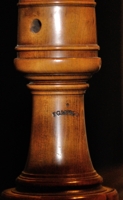PHILIPPE BOLTON
HANDMADE RECORDERS & FLAGEOLETS
THE REVIVAL OF THE RECORDER

The revival of the recorder began towards the end of the 19th century, when interest was growing for music of the past. At the same time museums were starting to build up collections of early instruments. Among these was the Museum of the Conservatoire Royal in Brussels, founded by the instrument maker and acoustician Victor Charles Mahillon. At first the instruments were there, but their playing technique was not generally known.
Arnold & Carl Dolmetsch
Arnold Dolmetsch is considered to be one of the principal pioneers of the recorder revival.
He was born in 1858 in Le Mans and came from a family of organ builders. He went to Brussels to study the violin,
and met some musicans there who were interested in renaissance and baroque music, and who played some of the instruments belonging to the museum.
Later he went to London to enter the newly founded Royal College of Music, where he discovered the music of Purcell, Handel and
other composers of the 17th and 18th centuries .
At an auction sale he bought an alto recorder by Bressan (Pierre Jaillard), the famous London maker, and played this in concerts.
Some time later this instrument was unfortunately lost, having been forgotten on a platform at Waterloo Station. The regrettable event led Dolmetsch
to make a recorder as a remplacement, and then to build others for his family and friends. This was the start of the Dolmetsch workshop,
that specialised in the production of high quality had made instruments
Dolmetsch settled in Haslemere, and, in 1925, launched a festival there where his instruments could
be heard, and which was was to become an annual event.
Carl, his youngest son, began to study music, and became a talented recorder player. After his father's death in 1940 he took over the
management of the festival. He played regularly in concerts, and gave first performances of works written for him by contemporary composers like Herbert Murril, Edmund Rubbra,
Lennox Berkely and many others.

a soprano (descant) recorder from the Dolmetsch workshop
Peter Harlan & the recorder in Germany
However Arnold Dolmetsch was not the first person to take up the challenge. About 10 years previously Gottfried Gerlach, from Munich, had made
a copy of an original recorder by Denner for an early music ensemble called the Bogenhausen Künstlerkapelle.
The recorder continued to progress in Germany under the influence of musicians such as Gustav Scheck et Willibald Gurlitt.
However the instrument was soon to take another direction there when Peter Harlan, a guitar maker from Markneukirchen, paid a visit to Haslemere.
He became aware of the recorder's potentialities, and started to have it built industrially. He modified the design to his own taste to make it
into an "uncomplicated folk instrument". In order to make it easier to play and more accessible to beginners he invented a simplfied, diatonic fingering system today called
German fingering. This does in fact facilitate the basic scale, but causes intonation problems in other keys.
This new instrument was adopted by the German youth movements, and responded to a desire to "return to simple and spiritual values and seek truth and beauty in all aspects of everyday life".

an alto (treble) recorder signed by Peter Harlan
Edgar Hunt & the democratization of the recorder in England
The Dolmetsch worshop only produced expensive hand made instruments. So Edgar Hunt, another enthusiastic player, arranged to have mass produced German recorders
imported to England at much more affordable prices. However he insisted on these being tuned to traditional English fingerings in order to avoid the intonation
problems inherent to the German system.
Because of the impossibility of continuing to import recorders from Germany during the war, Hunt had recorders made in England from plastic, and the instrument's
development continued. Bakelite was first used for this. Being somewhat brittle it was later replaced by ABS.
As consequence of these events more and more people were playing the recorder, including in schools, but there were very few players at a professionnal level.
Evolution ultérieure
Things changed during the second half of the 20th century. The standard of playing and teaching became progressively higher and more demanding. Experienced players like Hans Martin Linde and Kees Otten were exploring its expressive possibilities at a level never reached before. During the 1960s and 1970s, under the influence of an outstanding musician, Frans Brüggen, followed by his pupils and by those who came after them, the recorder made another large step forward, in Holland first, then all over the world.

a soprano (descant) recorder made by Hans Coolsma around 1970
This also coincided with the revival of baroque and earlier repertoires. At the same time time makers like Hans Coolsma, Bob Marvin, Friedrich von Huene,
Fred Morgan, Andreas Glatt and many others were closely examining and reproducing the original instruments in different museums whose musical qualities seemed to be head and shoulders above those being currently made.
This paved the way for further developments to suit the needs of contemporary players.
The revival arrived fairly late in France. Jean Henry a pioneer of its reintroduction, was one of the first recorder teachers there. He also orgainsed international courses, giving French students an opportunity to come into
contact with players from other countries. Claude Monin was the first Frenchman to begin making recorders in the 1960s.
Thanks to all these people the recorder has regained the place it occupies today on the musical scene.

a renaissance alto recorder in g by Bob Marvin made in 1978